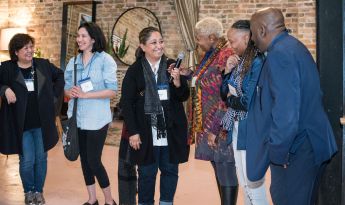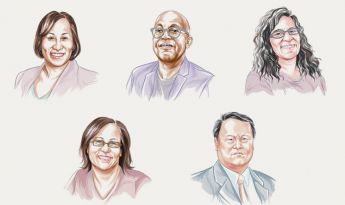The Bush legacy of investing in leaders predates the formation of the Bush Foundation in 1953. “Archie Bush (founder of the Bush Foundation, along with his wife Edyth) believed in investing in extraordinary leaders,” says Anita Patel, leadership programs director for the Bush Foundation. “That tradition came straight from him; now the Foundation has been doing it for over 50 years.”
The Bush Fellowship’s focus is on the development of individual leaders who are working to promote change both in themselves and their communities. “The focus is not on helping Fellows pursue a particular issue or project, but on allowing them to really concentrate on their leadership growth,” says Patel. 24 Bush Fellows are selected each year by panels of Bush Fellow alumni, Foundation staff and community leaders.
Below, hear from a few of the people behind Bush Fellowship selection.
Eight to 12 groups of five Bush Fellow alumni complete the first round of the screening process.
Every Bush Fellowship application is read by human beings — there are no computer screenings. Eight to 12 groups of five Bush Fellow alumni complete the first round of the screening process, selecting approximately 150 quarterfinalists to advance. Each group of alumni readers comprises a mix of sectors, geography, genders, and racial and ethnic identities reflecting the diversity of our region. Committee members receive extensive training to understand the Fellowship selection criteria, including keeping context in mind and building awareness of implicit and explicit biases, says Patel. “We then do some practice with them to make sure they feel supported and that they’re embodying the philosophy of the Bush Foundation.”

“I’m looking for someone who really knows who they are.”
Kou Thao
Kou Thao (BF’13), Director of the Center for Health Equity & Office of Minority & Multicultural Health at the Minnesota Department of Health, has served as an alumni reader. He says,
“I’m looking for someone who really knows who they are. I want to see how they’re using their journey so far to inform the impact they want to have, that they’re really clear on what that impact is and what they need to get to the next level of their leadership.
I am also looking for a focus on their own leadership development, as opposed to a project they want to do. They should be able to identify their leadership blind spots and recognize the gaps that the Fellowship could help equip them to overcome.”
A diverse mix of Bush Foundation staff with a range of areas of expertise reads the applications forwarded by the initial screening committee.
Staff readers work in two rounds: the first round selects up to 60 semifinalists to take part in phone interviews and reference checks, after which the second round of staff readers selects up to 36 finalists.

“I’m looking for people who have a vision for themselves that takes them beyond their current work.”
Eileen Briggs
Eileen Briggs (BF’16), Nation Building and Government Redesign Portfolio Director at the Bush Foundation, has served as a staff reader. She says,
“I’m always considering the selection criteria. I’m looking for people who have a vision for themselves that takes them beyond their current work. Even though their plan may change in the future, someone who has a pathway to position themselves towards that vision.
I recommend moving someone along because the Fellowship could take them to a much greater level of impact. And that doesn’t necessarily mean that they will be doing more public work or become better-known. It might be someone who is going to go much deeper in their knowledge base or community.”
Finalists are invited to be interviewed by community leaders, some of whom are Bush Fellow alumni.
“These are folks who have had experience trying to make change in our region by scaling ideas and bringing people together,” says Patel. “They understand what it means to push yourself to grow.” These leaders aren’t looking for weakness, but for who is most ready to soar. Even for those who don’t get a Fellowship, the interviews deepen applicants’ understanding of how change happens and spark new connections.

"We need to answer the question, 'Is now the right time for this candidate to make the most of the Fellowship?'"
Michael Gorman
Michael Gorman, founding Managing Director of Split Rock Partners, has served as an interviewer. He says,
“By the time applicants have made it to this stage, they all have compelling stories and making final selections is quite difficult. Committee members look for the combination of potential impact and the fit for this award — the notion that the Fellowship is the key to unlocking the unique potential within the candidate.
The final selection process involves a great deal of discussion and discernment within the committee. We need to answer the question, 'Is now the right time for this candidate to make the most of the Fellowship?' Some candidates come back over multiple years, and applications improve as they hone in on the specific manner in which they can contribute to their communities.”








